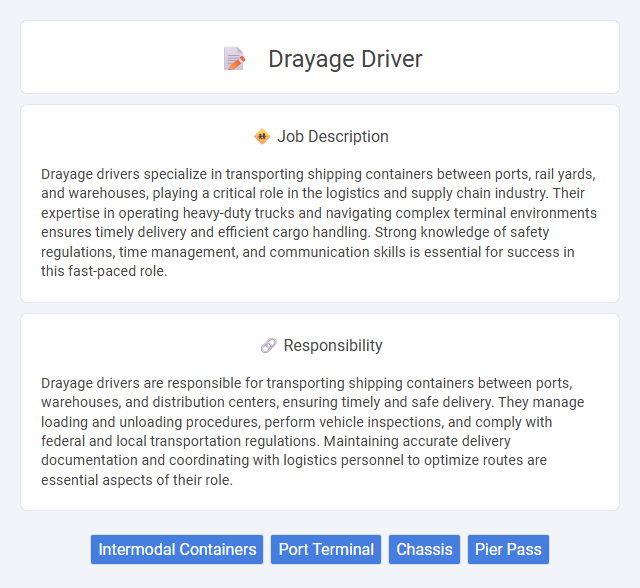
Drayage drivers specialize in transporting shipping containers between ports, rail yards, and warehouses, playing a critical role in the logistics and supply chain industry. Their expertise in operating heavy-duty trucks and navigating complex terminal environments ensures timely delivery and efficient cargo handling. Strong knowledge of safety regulations, time management, and communication skills is essential for success in this fast-paced role.
Drayage driving may suit individuals who are comfortable with long hours of physical activity and working in potentially stressful environments involving tight schedules and heavy traffic. People who adapt well to routine and have strong time-management skills might find this job fulfilling, while those sensitive to high-pressure situations or requiring a consistent indoor environment may find it less suitable. The likelihood of success increases for drivers with good spatial awareness and a strong sense of responsibility for handling valuable cargo safely.
Qualification
Drayage drivers must possess a valid commercial driver's license (CDL) with a tanker or hazardous materials endorsement in many cases due to the transportation of freight containers. Experience in operating heavy-duty trucks, along with knowledge of local traffic laws and safety regulations, is essential for efficient and secure deliveries. Strong physical stamina and the ability to handle demanding schedules improve job performance in this vital logistics role.
Responsibility
Drayage drivers are responsible for transporting shipping containers between ports, warehouses, and distribution centers, ensuring timely and safe delivery. They manage loading and unloading procedures, perform vehicle inspections, and comply with federal and local transportation regulations. Maintaining accurate delivery documentation and coordinating with logistics personnel to optimize routes are essential aspects of their role.
Benefit
Drayage drivers may experience benefits such as competitive wages and opportunities for overtime pay, enhancing their overall income potential. Access to health insurance and retirement plans might be provided, contributing to financial security and well-being. Flexible schedules and the chance to gain experience with various types of cargo could also improve job satisfaction and career growth prospects.
Challenge
Drayage driver jobs likely involve navigating tight schedules and congested ports, creating a constant challenge in meeting delivery deadlines. The probability of encountering unexpected delays, such as traffic or equipment issues, can demand quick problem-solving skills and adaptability. Managing heavy loads and ensuring safety protocols adds another layer of complexity to the daily responsibilities of drayage drivers.
Career Advancement
Drayage driver jobs offer essential roles in the logistics and freight industry, providing critical last-mile transportation of shipping containers between ports, rail yards, and warehouses. Career advancement opportunities include transitioning to long-haul trucking, supervisory positions, or logistics coordination roles, supported by gaining certifications in hazardous materials handling or obtaining a commercial driver's license (CDL) with endorsements. Employers often provide training programs that enhance skill sets, improve safety records, and increase earning potential within a growing supply chain sector.
Key Terms
Intermodal Containers
Drayage drivers specialize in transporting intermodal containers between ports, rail terminals, and distribution centers, ensuring efficient cargo movement within the supply chain. Their role is critical for timely delivery of goods, requiring expertise in handling secure container attachments and navigating complex yard operations. Proficiency in managing container dimensions, weight restrictions, and adherence to safety regulations enhances operational efficiency in drayage services.
Port Terminal
Drayage drivers play a critical role in port terminal operations by transporting containers between the port and nearby warehouses or distribution centers. Efficient drayage services reduce congestion and turnaround times at busy port terminals, enhancing overall supply chain performance. Expertise in navigating terminal layouts and compliance with port regulations is essential for drayage drivers to maintain seamless cargo flow.
Chassis
Drayage drivers play a crucial role in transporting chassis between ports, rail yards, and warehouses, ensuring the seamless movement of shipping containers. Expertise in chassis inspection, maintenance, and proper handling is essential to prevent delays and damage during intermodal transfers. Timely and safe relocation of chassis supports efficient logistics operations and reduces overall supply chain costs.
Pier Pass
Drayage drivers play a crucial role in the efficient transportation of containers between ports and warehouses, directly impacting supply chain reliability. PierPass is a program designed to reduce congestion at Los Angeles and Long Beach ports by incentivizing off-peak drayage trips through a Traffic Mitigation Fee, which drayage drivers must factor into their scheduling and pricing. Understanding PierPass regulations helps drayage drivers optimize routes, avoid peak-hour delays, and increase overall operational efficiency.
 kuljobs.com
kuljobs.com